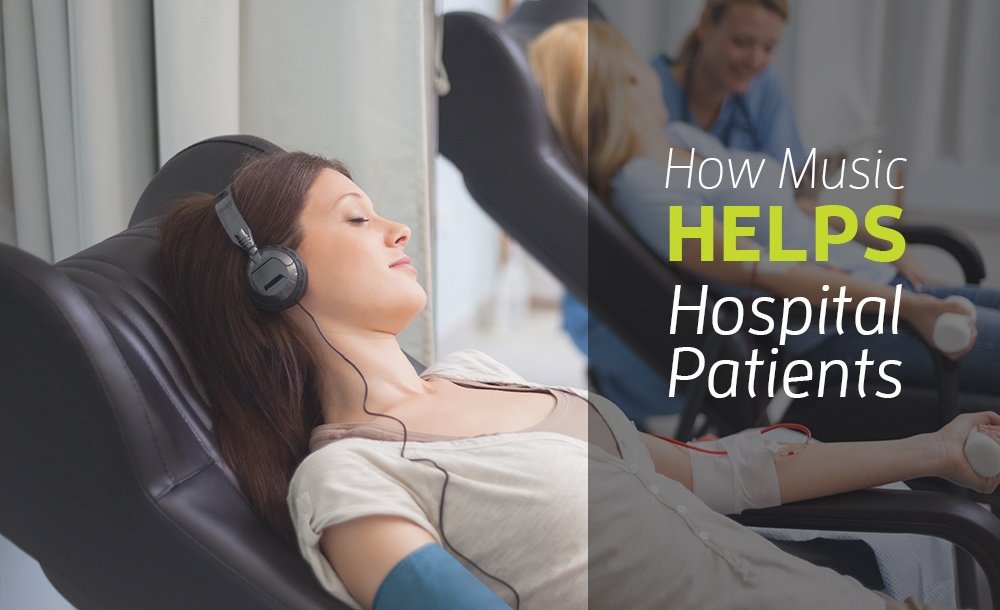
In most medical facilities, music isn’t a top priority. It’s simply used as overhead or background music that fills in the silence. But researchers are finding that music for hospitals is way more powerful than most of us realize.
According to Harvard Health Publications, there is a growing body of research that shows music can actually help improve medical outcomes.
How Music Benefits Healthcare Patients
Research shows that music can:
- Help patients feel less anxious before a procedure. Controlled clinical trials that measured the anxiety of patients who were about to have colonoscopies, cardiac angiography, and knee surgery, found that patients who listened to music before their procedure had reduced anxiety.
- Decrease patient discomfort. The same study also measured patient discomfort during the procedure. It found that patients who listened to music in the operating room reported less discomfort during the procedure.
- Reduce side effects. When music for hospitals is played during chemotherapy and radiation treatments, it has been shown to decrease nausea in patients.
- Decrease levels of pain. Patients with pain ranging from short-term to chronic pain had a decreased perception of pain and required less pain medication after using music therapy.
- Improve moods. Patients dealing with pain also showed signs of a decrease in depression and improved attitude after using music therapy. They reported feeling more in control over their pain.
- Aid in physical therapy and rehabilitation. Several studies have found that music improves “physical, psychological, cognitive, and emotional functioning during physical rehabilitation programs.” Music has also helped people regain their speech after brain injuries and strokes, and it has improved the quality of life for people dealing with dementia.
It’s important to note that these benefits are not necessarily a result of the presence of overhead music for hospitals. In many of these situations, the connection to the music goes deeper than that.
Music tied to specific medical benefits are often delivered through music therapy. Certified music therapists work with patients through programs that may include both listening to and playing music.
But nonetheless, these benefits and outcomes can serve as a guide to lead more hospitals and healthcare locations to put a stronger emphasis on using music throughout their facilities.
How To Better Utilize Music for Hospitals
Simply adding music can create amazing, powerful results in healthcare. So providers need to consider how they can improve music for hospitals, as well as private practices and other medical locations.
Leave no room in silence. Music is proven to calm nerves and aid in relaxation so utilize overhead music in all of the rooms and areas of your healthcare facility. Ensure that patients and their loved ones are never left in silence in:
- Waiting areas
- Hallways
- Nurses stations
- Exam rooms
- Operating rooms
- Recovery rooms
Carefully consider your musical selection. Music has an impact on people’s feelings and moods, so choose your playlist carefully to ensure that it suits your patients and their loved ones. Consider how you want the music to impact and serve your patients and select the playlist that best matches those goals.
Do your research to find what type of music will match the results you want to create. For example, if you are working with dementia patients, you may want to play orchestra songs as that has been proven to help boost confidence in people with dementia (HealthLine). Or, if you want to uplift the mood of your patients, select upbeat music and avoid sad, melancholy songs that can have a negative effect on patients.
Also, make sure that your music for hospitals is suitable for your staff too. Overhead music that is constantly played in a location can frustrate employees. So choose playlists that won’t annoy your doctors, nurses, and administration.
Give patients options. If you want to really use music to help patients, put the power in their hands. Offer tools that allow them to select and listen to music on their own.
- Offer headphones
- Provide a library of music
- Use interactive digital signs that allow patients to make selections
Consider working with a licensed professional. If you aren’t sure how you can use music to improve the healthcare outcomes for your patients, consider working with a licensed music therapist. They can help you develop plans proven to work specifically for your type of patient or treatment.
Don’t overdo it. As with most things, music for hospitals must be delivered with the right amount of moderation. When you set up sound systems in your rooms and hallways, ensure that you have the right volume and balance.
While music can have a positive impact on the morale of patients, it can quickly create a negative impact if the sound is too loud or invasive. Work with audio and video specialists to get the right volume and quality.
Learn More…
Music for hospitals is just one of the ways that you can improve the environment of your healthcare location in order to provide better patient experiences and healthcare outcomes. Things like interactive wayfinding, informative digital signs and other improvements can improve your patients’ experiences and help to modernize your location.
To discover more ways to provide exceptional environments, experiences, and outcomes for patients, get our Free 2017 Guide to Outpatient Customer Experiences.
In this guide, we’ll share other changes your medical facility may be overlooking that could have a big impact on your practice and patients.